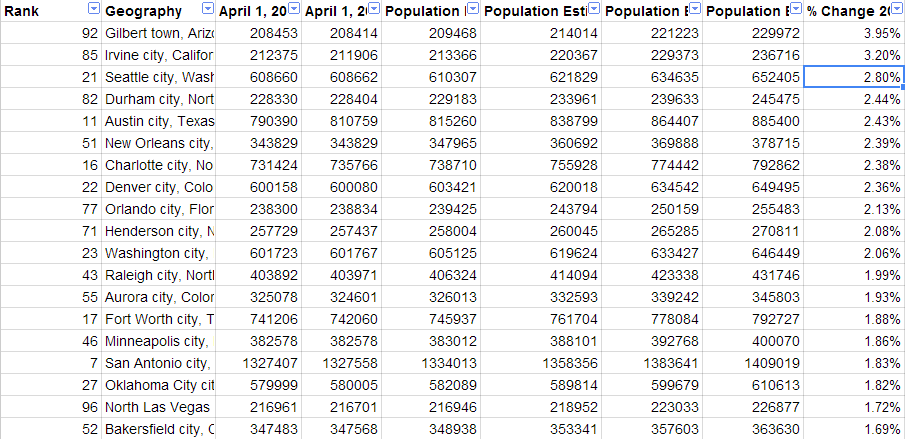Yesterday morning the Census Bureau published a press release titled, “South, West Have Fastest-Growing Cities, Census Bureau Reports; Three of Top 10 are in Texas Capital Area.” The article has links to the best estimates for growth between July 2012 to July 2013. Sure enough, three cities in central Texas top the list. These three municipalities (suburbs of Austin, TX) are growing rapidly, as much as 8%. But which big city is the fastest growing in the country. Here’s a glimpse at the top 100 ranked by growth:

The estimates show Seattle growing 2.8% from July 2012 to July 2013. This is behind two other cities in the top 100 but it is the fastest growing of the top 50. Beyond this simplification the measurement becomes a little trickier.
How Do You Measure A City’s Geographic Area
Before measuring population, it’s necessary to define the boundaries of a city. The easiest measurement to use is simply drawing the boundaries at the legal edges of the city. This is simple enough and makes a lot of measurements easy but often times the legal boundaries of cities don’t match our perceptions. For example, is Shoreline part of Seattle? With this measurement the answer would be no. You see examples like this everywhere. If you asked someone living across the river in New Jersey where they were from it wouldn’t be unusual if they said New York City. Just like many people around New York identify as New Yorkers, people who live on Mercer Island likely identify as Seattlites but Mercer Island also isn’t within Seattle’s legal boundaries.
This is also true in Austin, TX. People who live in Round Rock, Georgetown or Cedar Park very likely identify as being from Austin. If you consider the growth in these municipalities, Austin’s growth rate jumps above 2.7%, still less than Seattle but significantly higher. If you include Seattle’s suburbs in the equation of growth, Seattle actually grew slower. For example, including Bellevue (1.37%), Redmond (1.67%), Renton (1.27%), Kent (1.18%) and Shoreline (.69%), would mean Seattle only grew 2.15%.
Additionally, Austin is much larger than Seattle if you compare their incorporated boundaries. Seattle only has about 84 square miles of land compared to over 320 square miles in Austin. A conservative estimate of Austin’s urban metro area is over 500 square miles. Is it a good comparison to juxtapose these two incorporated areas?
Incorporated Areas Do Matter
If you are attempting to determine government policy that is leading to good outcomes, measuring areas by the incorporated boundaries might be the best strategy. While there is a lot of influence on cities from county, regional and state politics, city policy has a big impact on the two factors that influence population growth, jobs and housing costs. Taking this into consideration paints an even brighter picture of Seattle’s growth. I cant help but speculate that policies put in place over the last few years are part of the reason why Seattle is growing faster than its suburbs. The opposite is true in Austin. Many of the people living in the suburbs likely identify as Austinites but, for whatever reason, choose not to live within the actual city limits.
When more people can choose to live in Seattle it has a real, measurable impact. City services cost less per person, diversity grows and our tax base broadens. Other, harder to measure factors also improve such as the resiliency of the city, dynamism and the lowered environmental impact. Overall, it’s a win for everyone when Seattle grows faster than its suburbs.
Seattle Is One Of The Fastest Growing Cities
Where the boundaries are drawn for a city greatly influences population estimates. Still, there’s no doubt that the city of Seattle is among the fastest growing in the country. It’s extremely difficult to do an apples-to-apples comparison but it seems to be on par or greater than all the other fast growing cities in the county. The one take-away that I think is most important is that the city of Seattle grew faster than its suburbs, meaning the city is both a desirable place to live and we are actually making some room for new Seattlites.
If you’d like to look at more of the data, perhaps coming up with estimates for the metro area, I’ve put it all in a spreadsheet here.

Owen Pickford
Owen is a solutions engineer for a software company. He has an amateur interest in urban policy, focusing on housing. His primary mode is a bicycle but isn't ashamed of riding down the hill and taking the bus back up. Feel free to tweet at him: @pickovven.

